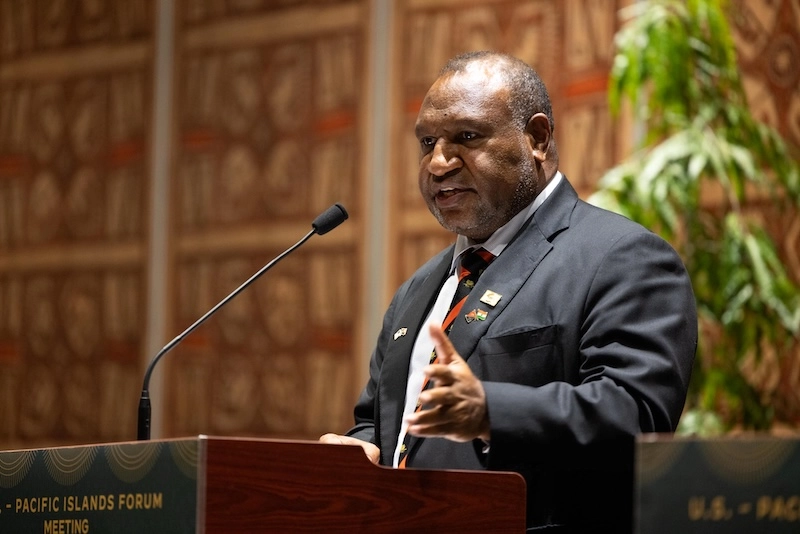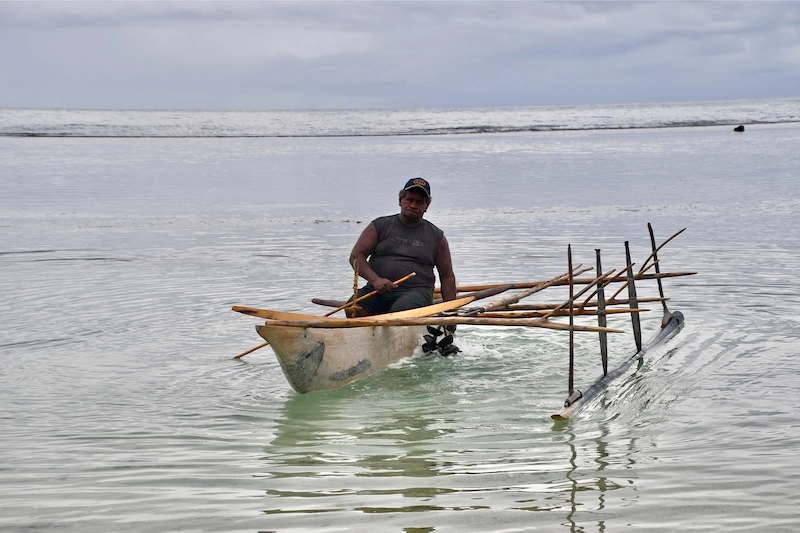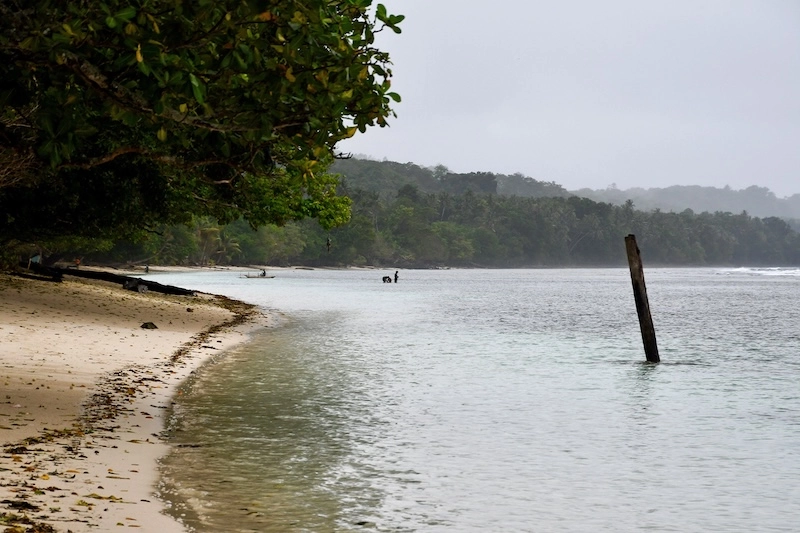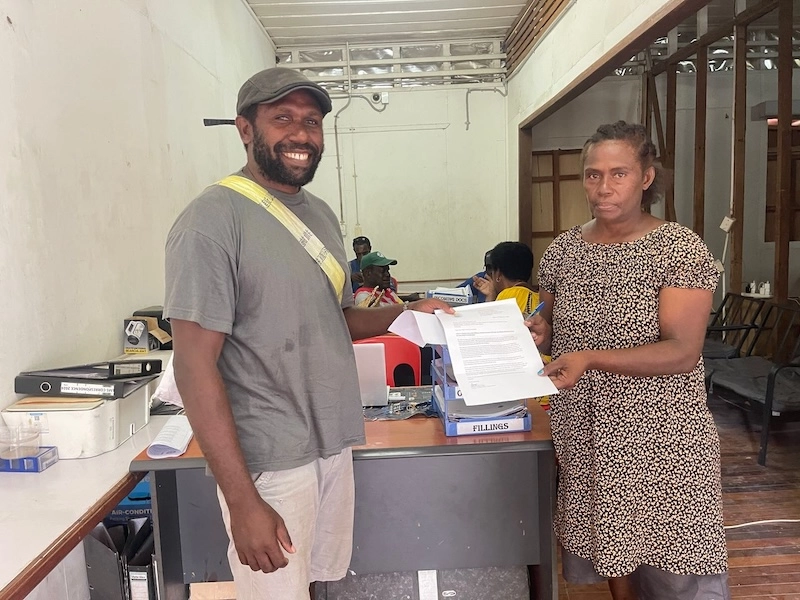- Papua New Guineas prime minister, James Marape, opposes deep-sea mining in Papua New Guinea, according to comments made at the United Nations Ocean Conference and directly to Mongabay.
- Contradicting his position, however, is the governor of PNGs New Ireland province, Walter Schnaubelt, who has vocally supported mining the Solwara 1 project and reportedly met with company and national government officials about extracting copper and gold from the seabed.
- From early on, the project has faced opposition from coastal communities living near the Solwara 1 site who are concerned about the impacts of mining on seafloor ecosystems and the fisheries on which they rely. In February 2025, they formally requested a forum to voice their grievances and hear responses from the companies involved, but have yet to receive a response, they say.
- The company originally awarded the mining license went bankrupt in 2019, and other companies have since tried to resuscitate the project, but without consulting communities or informing them of the risks associated with deep-sea mining, according to the communities. In July 2024, the companies carried out trial mining; government officials say they were unaware of the ships presence, but internal documents and emails suggest that key leaders were likely aware that trial mining was planned as early as 2022.
This story was supported by the Pulitzer Centers Ocean Reporting Network, where Elizabeth Claire Alberts is a fellow.
NICE, France James Marape, the prime minister of Papua New Guinea, voiced his governments rejection of seabed mining at the 2025 United Nations Ocean Conference that took place between June 9 and 13, in Nice, France. His position stands in sharp contrast to the situation unfolding in the countrys New Ireland province, where local authorities are paving the way for foreign companies to begin mining the seabed, despite long-standing, community-led opposition to these developments.
As a country, we dont want any deep-sea mining in Papua New Guinea, Marape told Mongabay in an exclusive interview on the sidelines of the U.N. Ocean Conference (UNOC) on June 10. He said his country would uphold its moratoria against the industry one of which was announced in 2019, and another in 2023.
The main reason for this position, he said, is that the seas around Papua New Guinea (PNG) are sensitive and fragile and are home to important fisheries. Our waters are very fertile in as far as marine life is concerned, he said, adding that scientific evidence on how mining might affect marine ecosystems is scant. A recent brief from the U.N. secretary-generals scientific advisory board warns of irreversible potential impacts on sea life due to the destruction of seafloor habitat, sediment plumes and the release of toxins by deep-sea mining.
While Marape publicly asserted his opposition to the nascent industry, a proposed project to dig up copper and gold at a site known as Solwara 1 off the coast of New Ireland province in northeastern PNG appears to be moving ahead after years of dormancy, despite community opposition.
 Papua New Guinean Prime Minister James Marape. Image by Chuck Kennedy/U.S. Department of State via Flickr (Public domain).
Papua New Guinean Prime Minister James Marape. Image by Chuck Kennedy/U.S. Department of State via Flickr (Public domain).
Deep-sea mining is gaining momentum far beyond PNG, with companies exploring for seabed minerals in many parts of the ocean, from the Arctic to the Pacific to the Atlantic. Advocates for the industry say the minerals it aims to surface are essential for the transition to clean energy and for national security. But critics echo New Ireland communities worries that mining in the deep ocean could irreparably harm marine ecosystems and biodiversity, while disrupting fisheries, livelihoods and cultural heritage.
Communities in New Ireland, a remote part of PNG, have long raised such concerns, saying seabed mining could destroy their livelihoods, food supply and ancient cultural connection with the sea.
There is really a strong no to deep-sea mining in our communities, Godfrey Abage, a community leader from the village of Kono, some 30 kilometers (19 miles) east of the Solwara 1 site, told Mongabay, especially the communities within the Solwara 1 project area.
Despite a sustained community-led campaign against deep-sea mining for nearly a decade and a half, Walter Schnaubelt, the governor of New Ireland and member of parliament from the district of Namatanai, recently expressed his steadfast support for the Solwara 1 project.
I want [to] declare my stand that I support seabed mining, Schnaubelt said in a recorded speech posted on Facebook with an English translation. The speech, according to sources, took place at the Tinkoris hospital in Namatanai district in early June. Im not going to run and hide, he added, responding to community pushback to deep-sea mining. He contended in the speech that the fish people rely on for food live in the top 500 meters (1,640 feet) of the water column, and that the mining will take place far below that. An article in the newspaper PNG Bulletin also quoted Schnaubelt as saying hed made a public commitment to catch and eat fish from near the Solwara site to prove that the operations are safe.
Schnaubelt did not respond to requests for an interview from Mongabay.
 Chris Malagan, chief of the village of Kono, shakes a ring of coconut shells in the water, a way of calling sharks that is part of a cultural tradition on the west coast of New Ireland. Image by John Cannon/Mongabay.
Chris Malagan, chief of the village of Kono, shakes a ring of coconut shells in the water, a way of calling sharks that is part of a cultural tradition on the west coast of New Ireland. Image by John Cannon/Mongabay.
Mining New Ireland, full steam ahead?
Schnaubelt is reportedly involved in drawing up plans for a memorandum of understanding between the PNG-based company NIU Solwara and the provincial government of New Ireland, aimed at kick-starting the Solwara 1 project. According to a local report by the newspaper PNG Post-Courier, NIU Solwara is the new name of a firm called Nautilus Minerals Niugini Limited, previously listed as a subsidiary of the now-bankrupt Canadian company Nautilus Minerals and the original holder of the Solwara 1 mining license issued in 2011.
On May 22, Schnaubelt, Deputy Governor Greg Toxie Seth and national government officials met with representatives of NIU Solwara in New Ireland. In a widely published photo of participants at the meeting, Mongabay identified several individuals associated with companies that launched a controversial exploratory deep-sea mining operation off the coast of New Ireland in July 2024. Pictured are Chris Jordinson, an Australian businessman once convicted of insider trading who is reportedly the CEO of Deep Sea Mining Finance (DSMF), a private company registered in the British Virgin Islands; Matthias Bolliger, a Swiss national barred from serving in any corporate leadership roles on the Isle of Man and a DSMF shareholder, according to media reports; and Richard Parkinson, co-founder and director of SM2 Seabed Minerals, a Jersey-based seafloor mapping and mining company that has partnered with DSMF in a joint venture known as Sustainable Mining Solutions (SMS).
Also attending the meeting were representatives of PNG-owned Kumul Minerals Holdings Limited, the parent company of Eda Kopa Limited, which manages PNGs interests in mining projects and holds a 15% equity stake in the Solwara 1 project.
In addition to the closed-door meeting between government officials and miners, Schnaubelt has been trying to allay concerns in local communities about the impacts of deep-sea mining, arguing that the companies have assured him they will use new and minimally disruptive technology. In the video of his speech, he said the operators would use new mining methods that were more efficient and would cause minimal disturbance to the environment.
Parkinson did not respond to Mongabays requests for comment. In response to requests for comment, Jordinson referred Mongabay to the SMS website. Neither SMS representatives nor Schnaubelt responded to questions about whether the use of novel technology would require a new assessment of its environmental impacts, or if that technology was used during a recent exploratory mission by SMS.
Less than a year ago, in July 2024, journalist Willem Marx, who reported on the exploratory mission for PBS and later Scientific American , witnessed what he described as a 12-ton hydraulic claw biting into the seafloor and throwing up clouds of silt. Marx was on board the MV Coco, a ship owned by Guernsey-based, SM2-affiliated company Magellan. Marx also reported seeing the miners stockpiling mounds of excavated rock on the seabed on the video feed from a remotely operated vehicle.
The SMS website states that these stockpiles were used to expose the layer containing seafloor massive sulfides that form as a result of volcanic activity below the ocean bottom and are likely to bear valuable minerals copper and gold, in the case of the Solwara 1 site. The company page also says these stockpiles serve as sources of samples for further analysis and that they exported 140 metric tons of these samples, which was less than the 180 metric tons for which they had permission from the PNG government. Representatives did not respond to questions about the total tonnage of rock stockpiled during the May-July 2024 expedition.
Critics of the mission raised concerns about whether the companies were planning to return later to collect the stockpiled material and called into question whether the voyage was limited to an exploratory mission, and whether their activities were permitted under their current licenses. The SMS website, however, states that all activities that were part of the Cocos expedition in May-July 2024 were permitted, as confirmed by the Mineral Resources Authority (MRA) and were permitted under Papua New Guineas regulatory requirements.
 Community members hunt for food in the Kono lagoon. Image by John Cannon/Mongabay.
Community members hunt for food in the Kono lagoon. Image by John Cannon/Mongabay.
Conflicting positions
The operation aboard the MV Coco between May and July 2024 initiated without the local communities knowledge or consent marked the first clear sign of internal contradictions within the PNG government.
At the time of the operation, representatives of the PNG national government said they didnt know the Coco was operating in the countrys territorial waters.
For instance, Jerry Garry, managing director of PNGs Mineral Resources Authority (MRA), denied knowing anything about the operation in an interview with Marx. However, internal emails seen by Mongabay show that Garry and other government officials met with representatives of DSMF and SM2, including Jordinson and Parkinson, on March 2, 2022. A week later, in a subsequent brief to the minister for mining, Garry laid out the companies plans in an email, which included trial mining in 2022 and commercial production beginning in 2024. It is not clear whether any trial mining took place before 2024.
Garry did not respond to Mongabays requests for comment.
Prime Minister Marape also denied knowing about the Cocos voyage. We had no idea, Marape told Mongabay at UNOC. All of us are caught by surprise. Marape also said he had no idea about the reported stockpiling of minerals that took place in 2024.
While its uncertain how much the government knew about the operation, especially as official statements contradict other evidence, Abage, the community leader, said local communities on the west coast of New Ireland close to the Solwara 1 site were not informed about any sort of mining exploratory or commercial occurring off their coastline.
When New Ireland residents saw the footage of the mineral harvests in July 2024, they were confused and afraid, Abage said. And they were also incredulous when they learned that officials in the capital of Port Moresby said they didnt know about the presence of the MV Coco in PNGs territorial waters.
Both the PNG Environment Act 2000 and the Mining Act 1992 require community consultation by companies involved in development projects such as mining and by the relevant ministries. In February, Abage formally requested a public forum in the town of Namatanai with DSMF through Governor Schnaubelt. The letter raises concerns about the significant implications from deep-sea mining to communities.
The letter also highlights the importance that communities be fully informed about the potential benefits, risks and challenges as a result of the project, Abage writes.
Abage said Schnaubelt has not responded officially, but instead sent him text messages (subsequently seen by Mongabay), in which Schnaubelt said it would be Abages responsibility to arrange funding for transport of community members to Namatanai. However, Abage said that would mean an hours-long journey by hired truck, dingy or canoe, which would be a heavy financial burden for the community.
Still, the communities remain in the dark about the future of deep-sea mining at the Solwara site, even as the Supreme Court recently ruled that the government must release key documents, including the environmental permit and the mining license.
For its part, SMS says on its website that Community consultation and awareness activities have been conducted since 2008 and are ongoing. Abage and other community leaders say the companies have not been present in their villages since 2019.
 Godfrey Abage, a community leader from the village of Kono in New Ireland, submitted a request for a community forum with Deep Sea Mining Finance to the office of Walter Schnaubelt, New Irelands governor, in February 2025. Image courtesy of Godfrey Abage.
Godfrey Abage, a community leader from the village of Kono in New Ireland, submitted a request for a community forum with Deep Sea Mining Finance to the office of Walter Schnaubelt, New Irelands governor, in February 2025. Image courtesy of Godfrey Abage.
A path toward protection
As for the support that Schnaubelt has thrown behind mining at the Solwara 1 site, Marape told Mongabay that Schnaubelts views are subservient to the laws of PNG. He can have his views, Marape added, but as a governor within a province, within a country.
Marape also said his government is in the process of investigating the SMS partners activities, both those planned for 2024 and their apparent current operations.
We thought theyd gone bust, Marape told Mongabay. We thought they left the country, but [they] are sneaking back into the country. So Im concerned about the manner in which they came in & knowing fully well, theres a moratorium on deep-sea mining. They came in back using [an] old license, and were asking for [a] full report on what has happened.
In line with this concern, the prime minister noted that his government had not issued any new mining licenses, in keeping with two deep-sea mining moratoria to which PNG is a signatory.
Meanwhile, PNGs marine territory is poised to play a pivotal role in a groundbreaking conservation effort. The countrys waters are set to become part of the first Indigenous-led, international ocean reserve, known as the Melanesian Ocean Reserve and announced by fellow South Pacific nations Vanuatu and the Solomon Islands on June 12 at UNOC.
Even as PNG prepares to join this landmark Indigenous-led ocean reserve, the internal contradictions around deep-sea mining remain a challenge for Marape to address, Joey Tau, coordinator of the regional watchdog Pacific Network on Globalisation (PANG), told Mongabay at UNOC.
Our call as civil society representative groups working in the environmental space is to go back and impose a moratorium, he said, adding that they would give the country time to craft specific regulations and engage communities in consultation. Prime Minister Marape needs to get busy.
For his part, the prime minister made his position clear: As far as Im concerned, if theres any way to stop it, well stop it. Theres no deep-sea mining in our country, he told Mongabay. We need to protect ourselves.
Banner image: Striped barracuda (Sphyraena obtusata) in Papua New Guinea. Image courtesy of Jayne Jenkins/Ocean Image Bank.
Elizabeth Claire Alberts is a senior staff writer for Mongabay and a fellow with the Pulitzer Centers Ocean Reporting Network. Find her on Bluesky and LinkedIn.
John Cannon is a staff features writer with Mongabay. Find him on Bluesky and LinkedIn .
FEEDBACK: Use this form to send a message to the author of this post. If you want to post a public comment, you can do that at the bottom of the page.



